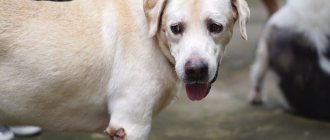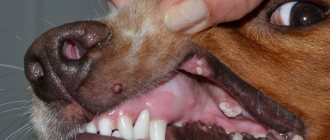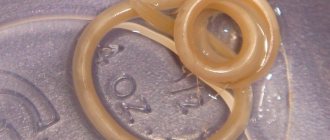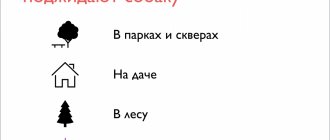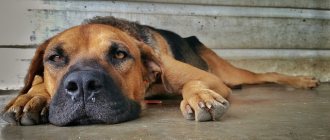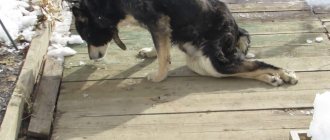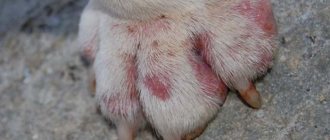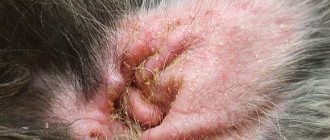Fungus is a colloquial term for a group of animal and human diseases caused by micromycetes.
I will talk about the types of fungus, the causes of diseases, and their symptoms. You will learn what mycoses and under what circumstances you can become infected from a pet. Familiarize yourself with diagnostic methods and treatment methods for fungal diseases. Find out what antifungal drugs and vaccines exist and how much they cost.
If after all this information you still have questions, ask in the comments.
Prices and information are current as of March 2021 and are constantly updated.
Types of mycoses and their locations
Fungal diseases can be classified in different ways. From a clinical point of view, the localization of mycosis and the specific type of pathogen are important. The main mycoses that affect dogs:
Dermatomycosis
Better known as lichen. The causative agents are Microsporum canis, Microsporum gypseum and Trichophyton mentagrophytes. As a rule, this disease affects the skin. These damages can vary in degree, depending on the dog’s immunity and the stage of neglect of the process.
Aspergellosis
A disease caused by mold fungi of the genus Aspergillus. It occurs not only in dogs, but also in cats, farm animals, birds, and very often in humans.
Comes in two forms:
Sinonasal aspergillosis . Most often found in this form. A lot of nasal diseases develop precisely because of this fungus. The causative agent of nasal aspergillosis is Aspergillus fumigatus. A distinctive feature is that most often this pathology occurs in young dogs with a medium or long muzzle.
The main signs of sinonasal mycosis:
- mucopurulent discharge from the nose;
- frequent sneezing;
- the dog experiences discomfort in the nasal cavity, at the same time pain and itching;
- minor nosebleeds;
- depigmentation on the nose (loss of color);
- ulcers may appear in place of depigmented areas;
- deterioration of general condition, lethargy, loss of appetite.
If the disease is neglected, the mycosis can reach the brain and then we can observe convulsions in the dog.
Systemic aspergillosis . In this case, the process affects both the lungs and the nervous system. This form is most typical for German Shepherds. Symptoms in this case are nonspecific:
- pneumonia;
- depression;
- convulsions and paralysis;
- sudden weight loss;
- increased temperature - fever;
- damage to internal organs, for example, if the kidneys are affected, then blood is found in the urine.
Candidiasis
Causes a pathogenic fungus of the genus Candida. This disease is popularly called thrush. The fungus can affect both the skin and mucous membranes. It is often found in the ears, in the oral and nasal cavities, as well as on the mucous membranes of the genital organs.
Symptoms:
- red lesions, erosions, peeling on the skin;
- if the oral mucosa is affected, excessive salivation and ulcers;
- if the nose is affected - inflammation of its mucous membrane (rhinitis);
- fungal conjunctivitis is manifested by lacrimation and cheesy purulent discharge from the eyes;
- photophobia;
- in the vaginal form - curdled mucous discharge from the genitals;
- itching
Blastomycosis
A disease caused by the yeast-like fungus Blastomyces. It is more common in dogs than in other animal species. NOT INFECTIOUS. This fungus lives in damp places, often in decaying foliage. The infection enters the body through the respiratory tract and affects organ systems. It occurs in two forms:
System . Internal organs are affected and subcutaneous tumors appear. In this form, blastomycosis acts as a malignant fungus. The prognosis is unfavorable. Main symptoms:
- dyspnea;
- frequent cough;
- fever;
- osteomyelitis, joint swelling;
- eye lesions;
- deterioration of general condition.
Cutaneous . Usually proceeds quite easily:
- the appearance of abscesses on the skin;
- nodules on the skin;
- itching
Malasesia
A disease caused by yeast fungi of the genus Malassezia. These fungi are classified as conditionally pathogenic, since they live on the skin of dogs normally, without causing any harm to health.
Under certain conditions, they begin to multiply quickly and cause dermatitis. In other words, Malassezia dermatitis usually develops against the background of another disease.
The spaces most often affected are the spaces between the fingers, folds of the lips, claws, ears and armpits. Places where sweating is increased or which are often damp. Characteristic features:
- the skin develops a very characteristic sweetish odor;
- claws turn brown;
- if the fungus is localized in the ears, then brown discharge from the ear is characteristic;
- the skin itself becomes thickened and oily (with an oily sheen and greasy);
- itching
The most common mycoses are listed above, but there are others, cases of which in dogs are rare in Russia, for example:
Histoplasmosis
A very small mushroom of the genus Histoplasma capsulatum. If it occurs, it is usually in hunting dogs. It enters the body through the respiratory tract, affects the lungs, and then the gastrointestinal tract.
Symptoms are nonspecific:
- weight loss;
- fever;
- enlarged lymph nodes;
- damage to internal organs, including hepatomegaly (enlarged liver);
- the nervous system is affected.
Cryptococcosis
Caused by yeast-like fungi Cryptococcus neoformans and Cryptococcus gattii. Very often they live in pigeon droppings. Infection occurs through the respiratory tract. This disease occurs in dogs, but even humans are affected more often.
Affected:
- respiratory system. The nasal mucosa is often affected;
- eyes, then we see keratoconjunctivitis and other pathologies. It can lead to blindness, but this is due to damage to the central nervous system;
- leather. Rare, as this fungus does not grow if the temperature is above 37 degrees. Therefore, skin lesions usually occur on the nose, ears, scrotum (in general, where the temperature is colder relative to the rest of the body);
- central nervous system. These are convulsions, meningitis is possible.
Coccidioidomycosis
The disease is usually observed in places with dry, hot climates. The fungi themselves are large, and their spores are small. As in other cases, infection is primarily through the respiratory tract.
Symptoms are nonspecific:
- temperature rise to 41 degrees;
- pneumonia;
- weight loss;
- bone lysis;
- eye damage.
Causes and routes of infection
Fungal diseases always develop against the background of reduced immunity.
This can be facilitated by:
- other diseases;
- immunodeficiencies;
- diabetes;
- pregnancy;
- puppies may have reduced immunity;
- unfavorable conditions of detention.
Also, constant dampness is an auxiliary factor for the development of fungal infection.
Since infection occurs primarily through inhalation of pathogens, if the dog has previously had respiratory tract infections, this may serve as an additional factor for infection.
Risk group
Fungal diseases, with the exception of dermatomycosis, are not very common in Russia, so the likelihood of infection is not high. But there is a breed predisposition.
Systemic aspergillosis is more common in German Shepherds, and sinonasal aspergillosis is more common in any dog with a medium or long muzzle.
West Highland White Terriers, German Shepherds, Basset Hounds, Shih Tzus, Dachshunds, Boxers and Poodles are genetically predisposed to mallasesial dermatitis.
Histoplasmosis mainly occurs in hunting dogs.
Common symptoms of dermatitis in dogs
There are general signs of pathology that you need to pay close attention to:
- redness of the affected area;
- increased skin temperature in the area of inflammation;
- hair loss (thinning or breaking off hair, thinning, complete loss);
- thinning of the walls of the capillaries (leading to their damage and bleeding);
- itching;
- swelling of the damaged area;
- painful sensations.
Subsequently, the focus of inflammation increases in size, spreading to other parts of the body. Ulcers, crusts, and suppurations appear. The dog's behavior changes, sleep and appetite are disturbed, and immunity is greatly reduced.
Diagnostics
Diagnostics includes several stages. And it must be carried out in a veterinary clinic.
To begin with, laboratory tests are carried out:
- It is necessary to donate blood, and in some cases, urine (for the presence of antigens), for analysis.
- The affected part of the skin or mucous membrane is sent for cytology. For dermatophytosis, scraping is done.
- Sowing for fungi.
- With the sinonasal form of the course, rhinoscopy is necessary to assess the condition of the nasal mucosa.
- In some cases, when bone lysis is suspected, an X-ray or CT scan with contrast is necessary.
- You won’t be able to make and confirm the diagnosis yourself at home, so in any case you need to contact a specialist.
Treatment
Treatment should be prescribed by a veterinarian after a full diagnosis. Since sometimes only local treatment is sufficient, in other cases the use of systemic drugs is required, and sometimes surgery cannot be avoided.
However, local treatment always takes place as it gives the greatest effectiveness.
For topical use, of all antifungal agents, clotrimazole cream is most often used. Clotrimazole effectively fights both yeast and mold fungi, and is also active against dermatophytes.
This is an effective and beneficial remedy. However, you should not prescribe it yourself and it is better to use it under the supervision of a veterinarian. Possible side effects from its use:
- irritation of skin and mucous membranes;
- refusal to eat;
- salivation.
Another option for an antifungal agent for external use is Enilconazole (as part of the drug “Imaverol”). It is active against the same fungi as clotrimazole, but is less toxic. The price may be more expensive than the first option.
In addition to local antifungal agents, systemic ones are used.
Itraconazole is a drug available in the form of tablets and capsules. Active against the same fungi, but does not act against candidiasis
Cannot be used without prescription from a specialist.
In addition to drug treatment, special procedures may be needed. For example, with the sinonasal form of mycosis (when the nasal mucosa is affected), rhinoscopy may be necessary for therapeutic purposes. A rather complex procedure is performed, for which the dog must be put to sleep.
Using rhinoscopy, the airways are cleared, and then the nose is washed using special catheters.
In other cases, especially when bone lysis has begun, surgical intervention is necessary, since direct access to the affected parts is required.
In addition, symptomatic therapy is necessary. For example, painkillers or anticonvulsants, if the central nervous system (CNS) is affected.
For fungal infections, it is necessary to take a very responsible approach to treatment, as it requires a lot of time.
Typically, the first results of therapy are visible within one to two weeks. But it’s too early to rejoice; sometimes treatment is delayed for a year or even more.
The peculiarity of mycoses is that relapses occur very often.
How to treat fungal dermatitis?
Treatment of fungus in dogs at the initial stage of the disease is carried out using a local method using shampoos or ointments. In advanced stages, drug treatment is carried out, which uses antifungal drugs.
Treatment of fungal dermatitis consists of the following series of measures:
- relief of itching and local anesthesia;
- treatment of affected skin areas with special ointments;
- systemic antibiotic therapy;
- detoxification and strengthening therapy.
A specific course is prescribed taking into account the general condition of the pet. To improve the clinical picture, the veterinarian may use the following treatments and medications for dogs.
- Local treatment according to the following scheme: ointment or cream (synthomycin ointment, Levomekol or Vishnevsky ointment) is applied to dry affected areas of the skin. The dressings are changed 1-2 times a day. Drying antimicrobial agents in the form of powders or solutions (streptocide or a solution of iodoform with boric acid) are applied to open wounds, weeping ulcers and pustules.
- Treatment with the antifungal agent fluconazole is effective. Pain syndrome is relieved by intravenous administration of 0.25% novocaine (dosage 5-20 ml, taking into account the weight and characteristics of the animal). The dog's condition is closely monitored by a veterinarian for several hours after the injection. Itching can be relieved with suprastin, tavegil or other antihistamines.
- Antibiotic therapy is actively used in cases of prolonged purulent disease. The course of treatment may be as follows: 15-30 mg/kg cephalexin 2 times a day for 1 week, 5-10 mg/kg enrofloxacin 1 time a day for 5 days and 0.2 ml/kg baytril 1 time a day for within 5-10 days depending on the condition of the infected animal.
- Autohemotherapy is necessary to improve the animal's condition. A modern method of skin treatment involves subcutaneous or intramuscular injection into the affected area of 5 ml of blood taken from the antebrachial saphenous vein. A total of 4 injections are given every 2, 3 or 4 days, depending on the course of the dog’s illness.
- Vitamin therapy is essential to improve immunity. In addition to the main treatment, the veterinarian additionally prescribes vitamins A, PP, B and E, immunofan, cycloveron and gamavit.
It is important to remember that self-treatment can lead to negative consequences and deterioration in the well-being of your pet.
Therefore, in order to cure dermatitis, you should immediately contact a veterinary clinic, where the doctor will conduct all the necessary studies, examinations and prescribe effective treatment. To avoid the formation and infection of a fungal infection, a number of preventive measures must be followed.
Briefly about the main thing
- Fungus or mycosis is a disease not only of dogs, but of many other animals and even humans, which is caused by pathogenic fungi.
- Mycoses always develop against the background of decreased immunity.
- There are many types of pathogenic fungi, which can be divided into: dermatophytes (lichen), yeast-like fungi and yeasts, molds.
- Fungi are mainly contracted by inhalation.
- Local treatment is more effective than tablets.
- The treatment process can drag on for a very long time, so you need to approach it responsibly.
Have we answered your question fully enough? If not, post your question in the comments below and our veterinarian will answer it.
Did you like the article? Share it with your friends on social media. networks. This will help them get useful information and support our project.
How to know if treatment is helping
On average, treatment for lichen in a dog can last up to 6 weeks (if the claws are affected, then up to a year). The prognosis is generally favorable.
- Scabs begin to separate on the affected areas
- New fur begins to grow
- Redness of the skin gradually disappears
- Itching is reduced
The effectiveness of treatment can only be accurately assessed using a Wood's lamp and taking scrapings and cultures from the skin of a sick dog. If in two tests taken at an interval of a month, the fungus that causes lichen is not found, then the dog is considered recovered.
